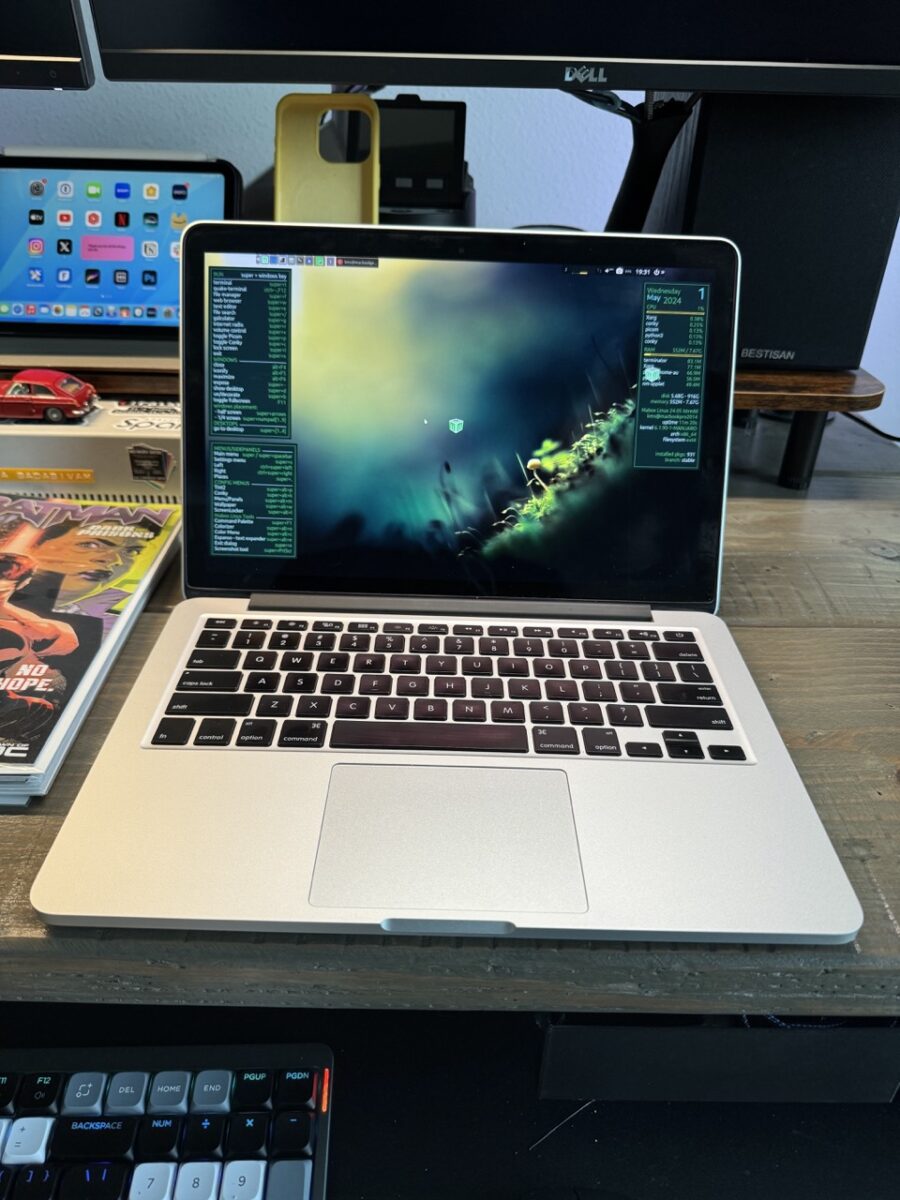MaBOX Linux: I Want to Believe
In my last post, I shared my experiences in upgrading my daughter’s 2014 13″ Retina MacBook Pro.
Apple claims that this machine is “vintage”, and, as such, has stopped providing system and security updates for it. Despite the fact that this particular model is a perfectly serviceable laptop, Apple wants its users to buy a new one. Not exactly environmentally friendly, huh, Apple?
To give this venerable MacBook Pro new life, I knew there was only one real option: Linux.
But which one?
Unlike macOS or Windows, where there’s only one current OS to choose from (macOS Sonoma or Windows 11, as of this writing), Linux comes in a multitude of “flavors”.
For new users, choosing a Linux distribution (distro) can be daunting. Each distro has its own look and feel. Some versions are catered more towards a normal user, while others cater to those who have more geeky proclivities. Mabox Linux is the latter.
I am no stranger when it comes to using Linux. I’ve been using Linux Mint on my 2008 Mac Pro “cheese-grater” tower for the past three years, and it’s served me well.
But this time around, I wanted to try a different distro: something with a much smaller RAM and storage footprint.
Mabox Linux got my attention due to its retro visual aesthetic and small footprint. It takes up only 300MB of space. Yes, you’ve read that last sentence correctly. 300MB. With such a small memory footprint, the 8GB of RAM on my MacBook Pro would be almost overkill, right?
Despite its size, Mabox Linux’s underpinnings are modern; it’s developed from a stable branch of the Linux Manjaro distro.
Mabox Linux uses OpenBox, a lightweight window manager. OpenBox eschews the decorative elements found on modern iterations of popular operating systems and focuses itself on being fast and responsive. It has a lot of appeal if you are using Linux on much older hardware. My own testing confirms that Mabox Linux is fast.
I installed Mabox Linux by first downloading the ISO from the website and using BalanaEtcher to make a bootable USB stick. The process took about 10 minutes.
After plugging in the USB stick, I fired up the MacBook Pro. Notably, the Mac did not chime. After a minute or so, Mabox Linux began its boot process. After another minute, I was presented with the Mabox desktop. Here, I could play around with the OS and get familiar with it.
Personally, I like the look and feel of Mabox Linux. It reminds me of computing in the mid-90’s, from a visual standpoint. I quite like its clean, stripped down interface. It’s… refreshing.
True to its description, Mabox Linux was incredibly fast. Opening and moving windows, accessing menus, etc. made this old MacBook feel new again. With my initial impression being good, I took the plunge and installed Mabox Linux on my MacBook Pro’s new 1TB Crucial NVMe SSD. Installation was fast, taking less than 4 minutes to complete.
I’m going to leave off screenshots and deep-dives on Mabox Linux here. There are numerous YouTube videos you can watch to see the UI and setup. I will say that Mabox Linux is wildly different from conventional Linux distros, and that may be a turn-off for someone coming over to Linux for the first time. Based on its UI and setup, Mabox Linux is not the Linux distro for newbs. To be fair, I love Mabox’s use of Conky palettes. These small interfaces show keyboard shortcuts and other useful info. To access any of your apps, you must right-click and select your app from the menu.
But despite my optimistic outlook, all was not beer and Skittles…
My biggest frustration with this distro came down to being unable to connect my MacBook Pro to my WiFi network.
Try as I might (and I tried for several hours) I simply could not get my MacBook Pro to see my Wifi network. I first tried tethering my MacBook Pro to my iPhone over Bluetooth, to see if I could pull down a driver update. While the laptop was able to get on the Internet by way of the iPhone, accessing pages via Firefox on Mabox was unbelievably slow). Next, I connected the laptop to my local network via a USB to Ethernet cable. This attempt was successful, and resulted in a much faster and more reliable connection.
Once online, I began my quest to get WiFi working. Numerous hours were spent Googling, checking Mabox’s and Reddit’s forums. After spending a full afternoon and evening and not having anything to show for it, I gave up. (Maybe I’m an idiot, but it shouldn’t be this hard to get WiFi going, on any operating system in 2024.)
I was crushed because I really hoped to spend more time with Mabox and use it for my everyday computing. Alas, it was not meant to be.
So, left with a wounded pride and utter disappointment, my attention turned towards trying another Linux distro: popOS.
More on that in an upcoming post.




DoContra
May 27, 2024 at 7:41 am(Maybe I’m an idiot, but it shouldn’t be this hard to get WiFi going, on any operating system in 2024.)
Unless your Wi-Fi is from Broadcom (from a pretty specific vintage), and your Operating System is Linux :(.
There are Three families of Broadcom drivers in GNU/Linux:
– b43/b43legacy: OG community driver for earlier Broadcom chips (up to around the transition between 802.11a/g and 802.11n)
– bcmwl: Legacy Broadcom proprietary driver, only driver for some of the early 802.11n chips
– bcrm[sf]mac: New, official open driver from Broadcom for the latter 802.11n chips and newer
From my experience, if your chip is only supported by bcmwl you’re gonna have a bad time :(. This driver uses its own set of userspace utilities/kernel APIs which limits encryption support to WPA2 and may cause havoc with iwd/GUI apps (The machines that I know of that have these chips and Linux do work with NetworkManager, but the lack of WPA3 support is very annoying — they straight-up do not connect to WPA2/WPA3 APs)